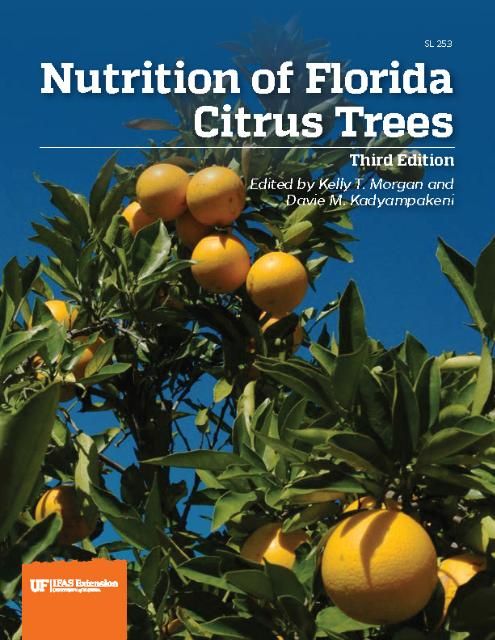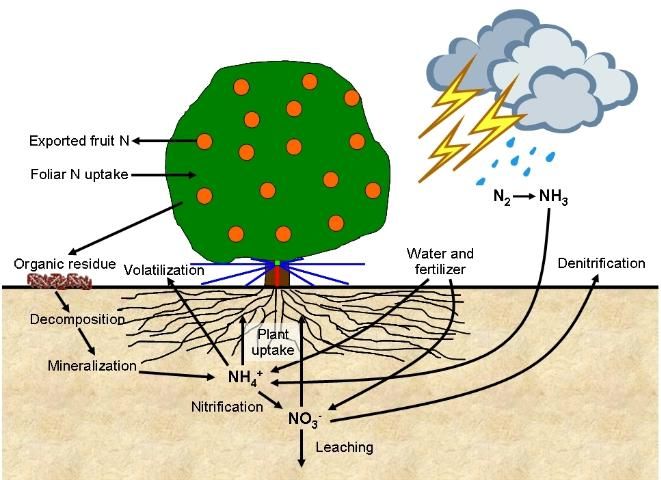
This publication is part of SL253, Nutrition of Florida Citrus Trees, 3rd Edition. For references, a glossary, and appendices, please refer to the full document at https://edis.ifas.ufl.edu/publication/ss478.
Environmental Nutrient Issues Related to Florida Citrus Production
Nitrogen is required for tree growth and fruit production. In a mature grove, however, there is little net increase in tree size. Nitrogen used for leaf growth or taken up by a cover crop is largely recycled as leaves drop or the cover crop dies, the vegetative material decomposes, and mineralization releases the N for reuse by the tree. This recycled N supplies most of the continuing need for new leaves, and relatively little fertilizer N is needed for growth. Replacement of the N removed by fruit harvest becomes the main N requirement in a mature grove. Figure 10.1 illustrates the citrus tree as a component in the environmental N cycle.

A 600 box/acre crop of oranges removes about 72 lb of N/acre from the grove. If this mature grove receives 200 lb N/acre annually, approximately 128 lb of N/acre remains to be accounted for after crop removal. The fate of this N is not completely understood. Some goes into new roots and shoots, and some is taken up by weeds. A portion of the rest may be lost by volatilization or denitrification, although denitrification in vulnerable soils is minimal. In controlled leaching studies, about 40% of the N applied to the soil is not recovered even when water is supplied soon after fertilizer application. Although unknown mechanisms may partially reduce the soil N concentration, a substantial portion of the N applied in fertilizer is subject to leaching as indicated by elevated N in groundwater beneath some groves. Clearly, excess N application should be avoided on vulnerable soils where the potential for leaching exists.
In the Flatwoods, most soils are slowly permeable due to the presence of spodic and/or argillic horizons (Chapter 2), so nitrate leaching to groundwater is less important than on the Ridge. In addition, nitrate that passes through the root zone to the shallow water table can be reduced to gaseous N through denitrification, which then disperses in the atmosphere.
Surface water contamination by nitrate is more likely to be a factor in the Flatwoods. Soluble nutrients that move more than about 30 inches below ground level become unavailable to Flatwoods citrus trees because of their shallow rooting depth. Dissolved nutrients, including P, may move laterally above the hardpan rather than vertically through the restrictive layers. As a result, leached nutrients can move into water furrows if rainfall or irrigation is excessive. Nutrients removed as a grove drains are readily used by algae, bacteria, and aquatic plants that often clog irrigation/drainage canals and ditches. Excessive vegetative growth in water furrows may be an indication of lateral nitrate movement.
The Best Management Practices (BMP) Era
In the late 1980s, FDEP surveyed the water quality from 3949 shallow (<100 ft) drinking-water wells across the state. Nitrate-N was detected in 2483 (63%) of these wells, and 584 contained a nitrate-N concentration greater than the national maximum contamination limit (MCL) of 10 ppm. Nearly 90% of the high-nitrate wells were located in Lake, Polk, and Highlands counties, the heart of Florida's central Ridge citrus production area (Chapter 2, Fig. 7).
In response to water quality concerns, a Nitrogen BMP bill was passed by the Florida Legislature in 1994 that authorized FDACS "to develop fertilizer BMPs designed to meet ground water standards.... These BMPs are not mandatory, but if the grower implements the BMPs...., the landowner or lessee will not be subject to administrative penalties if nitrate ground water standards are violated. The Department of Environmental Protection is authorized to conduct field monitoring...."
The definition of a BMP is a practice or combination of practices determined by the coordinating agencies, based on research, field-testing, and expert review, to be the most effective and practicable on-location means, including economic and technological considerations, for improving water quality in agricultural and urban discharges.
The first BMP that FDACS adopted by rule in response to the 1994 law was called "Nitrogen Best Management Practices for Florida Ridge Citrus." It specified N fertilizer sources, annual N rates, maximum N rate per application, fertilizer application timing, irrigation management, and record-keeping for citrus grown on permeable better-drained sandy soils typical of Florida's central Ridge. The purpose was to minimize the risk of leaching nitrates from fertilizers to groundwater.
Citrus production BMP development then followed in the Indian River growing region in response to surface-water quality concerns in the Indian River Lagoon and St. Lucie Estuary. These BMPs were developed for citrus on poorly drained Flatwoods soils. They expanded beyond nutrient management to include water volume, sediment transport, pesticides, and aquatic plants. Since then, similar BMP manuals have been developed for the Peace River and Gulf citrus-growing areas, so essentially all commercial Florida citrus groves can potentially come under the auspices of a BMP program if the grower so desires. Citrus growers are referred to the FDACS Office of Water Policy for more detailed information (https://www.fdacs.gov/Divisions-Offices/Agricultural-Water-Policy).
The following are the steps that growers need to take to get involved in their regional BMP program:
- Assess the grove operation and list BMPs that are already present or will be enacted.
- Submit the summary of practices to FDACS in a "Notice of Intent to Implement" BMPs.
- Once enrolled, maintain records and provide documentation regarding BMP implementation.
- Receive a "presumption of compliance" with water quality standards from FDACS.
After enrollment, growers become eligible for cost-share funding or drainage permit exemptions, depending on grove location.
Characteristics of a successful BMP program:
- A "cradle-to-grave" approach.
- A stakeholder-driven process from manual development through BMP implementation.
- Distribution of printed manuals to growers.
- Adoption of BMP manual by rule, followed by availability of cost-share for implementation.
- Growers keep good production records and use self-assessment tools.
- Third-party implementation teams help growers enroll and take part in BMPs.
- Field studies determine the effectiveness of BMPs.
- BMP education is a continuous process.
General Nutrient BMPs for Citrus Production
Nutrient BMPs do not represent exotic or unfamiliar fertilizer management practices to modern Florida citrus producers. In fact, most BMPs are simple, common-sense, "good housekeeping" practices that many grove managers already use in their normal caretaking. The following list summarizes typical nutrient BMPs found in Florida's various citrus BMP manuals:
- Educate and train field operators who handle, load, or apply fertilizers about fertilizer placement, avoiding waste, and preventing contamination of open water.
- Develop a nutrient management plan based on crop nutrient requirements.
- Use tissue and soil analysis to make fertilization decisions.
- Use appropriate application equipment.
- Properly calibrate and maintain application equipment.
- Apply fertilizers to target sites.
- Avoid high-risk applications such as before forecasted rainfall, on bare soils with extreme erosion potential, or when the water table is near the surface.
- Store fertilizer to prevent contamination of nearby ground and surface water. Always store fertilizer in areas protected from rainfall.
- If fertilizer is spilled on the ground, collect it and apply as normal. Use a tarp on ground surfaces where fertilizer is transferred.
- Use caution when loading near ditches, canals, and wells. Locate loading activities away from these sites if possible.
- Use multiple fertilizer loading and transfer sites to prevent concentration of nutrients in a single area.
- Use backflow prevention devices on irrigation and spray-tank filling systems to prevent entry of nutrients into surface or groundwater.
- Split fertilizer applications throughout the growing season.
- Use erosion-control practices to minimize soil loss and runoff.
- When irrigating, try to wet only the root zone. Do not overirrigate.
- Add organic matter to the soil whenever possible.
- Prevent groundwater contamination by plugging wells that are not in use.
- Use appropriate fertilizer sources and formulations based on nutritional needs, season of year, and anticipated weather conditions to achieve greatest efficiency and reduce potential for off-site transport.